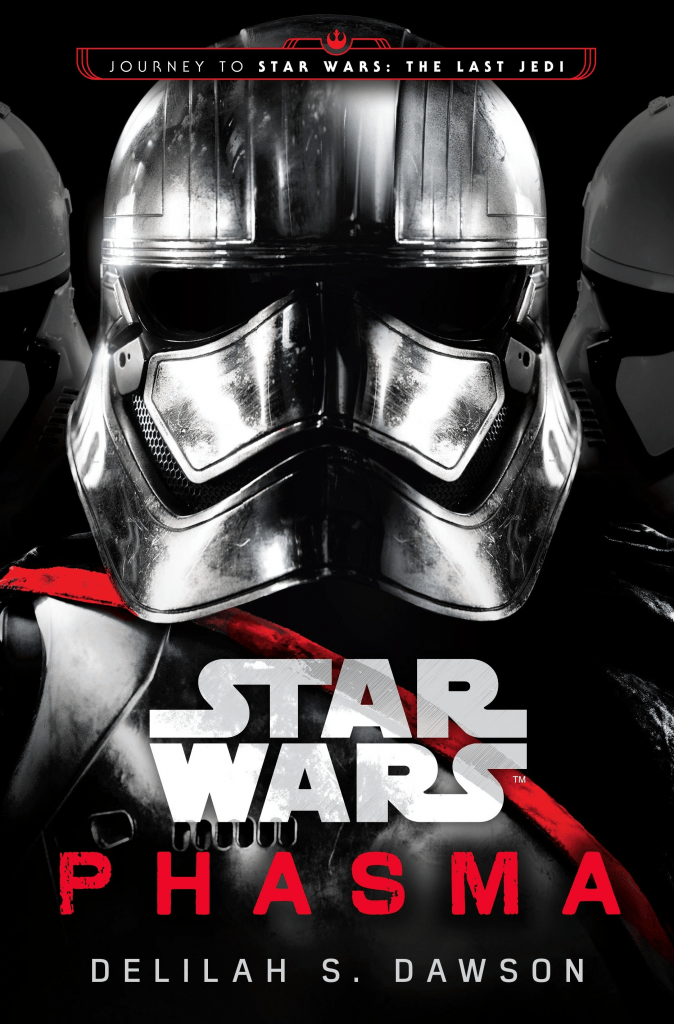Star Wars Beyond the Films‘ Nathan P. Butler is now posting short, non-spoiler reviews for many new releases. Spoiler-filled discussion will often follow in the weeks or months thereafter on the podcast.

Phasma by Delilah S. Dawson (hardcover, 2017)
In 2015, Delilah S. Dawson’s first Star Wars story, A Perfect Weapon (reviewed here), was released. Many fans wondered whether (or when) Dawson would return to Star Wars fiction, perhaps as part of the growing number of female Star Wars novel writers for the Story Group’s new Canon. Now, her first full-length novel, Phasma, has arrived as part of the Force Friday II product launch. Does this origin story for the mysterious, chrome-armored First Order captain provide the expected insight into the character? Is it worth the read?
Phasma
Few knew what to expect from a novel about Phasma’s background, since very little was known about the character prior to this tale. We knew that her armor was taken from an old chrome Naboo yacht once owned by Palpatine. We knew that she was the one who trained First Order stormtroopers. We knew she was female. (We also knew, if we can take a brief cynical turn here, that she was very much like Boba Fett in The Empire Strikes Back or Darth Maul in The Phantom Menace: a character hyped up as being cool based on character design but who had very little to actually do in the film to justify the hype built around her prior to the film’s release.) She was essentially a blank slate, but we knew we would learn more both from this novel and a Marvel Comics mini-series of the same name to begin just days after the novel’s launch for Force Friday II.
Phasma is told in a similar way to Tarkin. A “present” framing story (set sometime between Bloodline and The Force Awakens but no more specific than that) sees a Resistance spy interrogated by Cardinal, a red-armored counterpart to Phasma in charge of training young stormtroopers before they would then move on to Phasma for more advanced training. Cardinal wants dirt on Phasma, and the spy, Vi Moradi, has recently been to Phasma’s homeworld, where she learned about Phasma from a former member of her tribe. Chapters in this “present” are written in present tense, similar to the Aftermath novels (but with far less sentence fragments, thankfully).
The majority of the book is told in past tense as Vi recounts key events and a long journey from Phasma’s background on her homeworld, which eventually includes how she joined the First Order and her role in a key power transition within the First Order that had only been hinted at previously.
With a present framing story and numerous flashback chapters, comparisons to Tarkin are to be expected. Whereas Tarkin‘s present provided an interesting chase tale of its own, the present in Phasma is not particularly eventful until the very end and relies on a level of patience on Cardinal’s part and coincidence in the catpure of Vi in the first place that strain credulity. If we can set those elements of disbelife aside, the insights into how the Resistance trains its spies in elements of psychology is rather interesting. The present is definitely not a tale that would be worthy of a novel if told without the flashbacks that form the bulk of the book, however. In that sense, it devitates from the Tarkin formula.
Since the chapters in the past (generally 12 – 9 years prior to the novel’s present) are the core of Phasma, it is that story that will make or break the novel. Moreso than for most other recent Star Wars novels, I arould argue that “your mileage may vary” in terms of your appreciation for the story that ensues. Phasma is from a planet that has gone through a recent quasi-apocalypse, leaving primitive tribes with little knowledge of the technology that they lost over the last century or so. Phasma is a cunning, brutal warrior, who shares power with her brother, Keldo, who leads through intellect and has lost part of one of his legs. When a First Order ship carrying Brendol Hux (father of Armitage Hux of TFA) crashes on the planet, power struggles erupt and a journey across the terrain begins, culminating in the tale of how Phasma became the character we know (at least visually) beneath the chrome helmet.
The story told in Phasma’s past could perhaps be best described as a sort of Star Wars cross of Lord of the Flies with the Mad Max universe. If you are a fan of the pre-Fury Road films in the Mad Max franchise, you will probably feel right at home in this environment and enjoy the primitive, post-apocalyptic struggle that drives the tale. On the other hand, someone like me, who could barely get through the first three Mad Max films without falling asleep and was put off enough by them to have not bothered at all with Fury Road, the story will be a real slog to get through. I have no doubt that there will be some who find this novel outstanding for its gritty, primitive take on the galaxy far, far away’s favorite First Order captain, but I cannot count myself among them. This type of story is apparently just not for me.
Variants Galore
Over the last few years, variants of Star Wars comics have reached ridiculous numbers, with some Star Wars comics having over 100 variants for a single issue. Star Wars novels have tended to be a bit less prolific with their variants (which is good, given the cover price of a hardback novel compared to that of a single issue of a comic book), but variants have appeared. Usually, one can find a regular copy of a novel, an exclusive through Barnes and Noble that includes a bound-in poster of some kind, and possibly a copy through Books-a-Million that includes an extra signature page that is signed by the author (bound-in at the same place as a poster would be for Barnes and Noble). Every so often, we see a convention exclusive version as well, such as Thrawn at Celebration Orlando 2017 or Inferno Squad at San Diego Comic-Con 2017.
While Phasma did not (thus far) see any convention exclusive versions released, the initial launch included the most different variants relesaed thus far for any Star Wars novel on its initial release day. Fans could pick up a regular copy at most retailers, and Books-a-Million once again offered an oft-overlooked signed version with that special extra signature page inside. Bound-in posters were also available, but not just from Barnes and Noble this time. Instead, there were three different retailers offering exclusive versions with different posters. Each variant’s poster featured Phasma on one side and a different character on the back. The poster from Barnes and Noble (the usual source of such variants) featured Cardinal on the back. A variant from Target featured Vi. The Walmart variant featured Phasma’s brother Keldo. With a $28.99 cover price, collectors were in for a pretty hefty hit to their wallets, though most fans (read: more sane fans) would end up just grabbing a single copy and ignoring the others. (I, of course, was in the collector’s camp this time and ended up with each variant. It still hurts, days later.)
The Verdict
Your enjoyment of Phasma, perhaps more than in the case of any Story Group Canon novel thus far, will rely heavily upon your enjoyment of a particular type of story, namely post-apocalyptic, brutal, Mad Max-esque science fiction. If that style of tale appeals to you, you should find much to enjoy about Phasma. If that type of story tends to leave you cold, Phasma probably will too. I expect this novel to be one of the most polarizing in terms of review scores and recommendations (or lack thereof) in the last few years of Star Wars publishing. It is hard for me to recommend due to my personal lack of interest in such settings, but I can recommend it as important background for a character who had little to do in The Force Awakens and will (hopefully) have more of a chance to shine (no pun intended) in The Last Jedi.
Recommended for: Those interested in the the background of Phasma, espcially those to whom a Mad Max style setting is appealing.
Not recommended for: Those who have a very hard time getting through Mad Max-esque tales or cannot think of Lord of the Flies without getting “Kill the pig, cut her throat, spill her blood” stuck in their heads for hours (and not in a good way).
A review copy of Phasma was received shortly after release, but the copy read for this review was a signed copy ordered at retail through Books-a-Million. Copies of the Barnes and Noble, Walmart, and Target exclusive versions were also purchased at retail.
